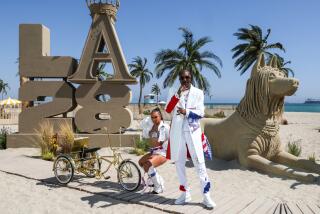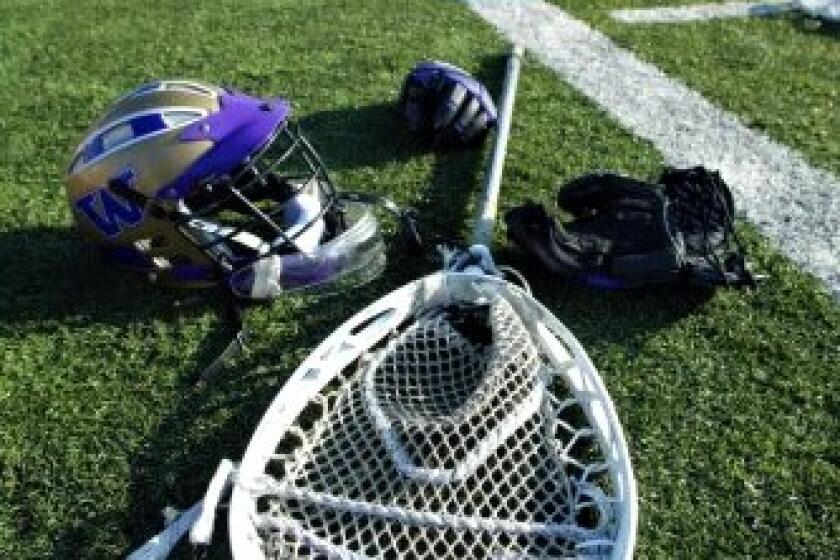Deforrest ‘Moe’ Most, 89; Gymnast Was Unofficial Ringmaster at Muscle Beach
- Share via
It was a circus under the sky where future fitness gurus formed human pyramids and amateur acrobats sailed through the air in front of thousands of spectators.
The unofficial ringmaster of the impromptu shows at Santa Monica’s Muscle Beach from the 1930s through the 1950s was Deforrest “Moe” Most, a gymnast who had a talent for persuading teenagers and tourists -- and the occasional celebrity -- that they too could join in.
“He was the ambassador for Muscle Beach,” said Paula Boelsems, an acrobat who trained there in the 1940s. “I can’t tell you how many times he did things for people ... and how many people stood on his shoulders.”
Most, who later worked as a prop maker for the studios, died of heart failure Saturday at Santa Monica-UCLA Medical Center, said his son, Steven. Most was 89 and had lived in Venice for decades.
“Moe was one of the greatest athletes I’ve ever known. We did tricks that nobody else had ever done,” said Jack LaLanne, one of the many physical fitness pioneers who got their start on the strip of sand.
“He also was a wonderful human being. If you had him as a friend, you were lucky,” LaLanne told The Times this week.
As a student at Belmont High in 1934, Most was one of the first regulars to discover Muscle Beach, a spit of beachfront south of the Santa Monica Pier where America’s obsession with fitness is said to have been born.
It was “such a perfect place to show kids that anything was possible,” LaLanne has said.
As director of Muscle Beach from 1947 to 1958, Most was in charge of the equipment and activities, including staging Mr. and Miss Muscle Beach contests and countless other quirky competitions involving feats of strength or gymnastic skills.
With his “gentle and confidence-instilling enthusiasm,” his father was able to give passersby a “thrill of a lifetime” that sometimes changed their lives, Steven Most said.
Bob Yerkes was 11 when he wandered onto the beach in 1943 looking for a game of table tennis. Most asked him, “Wouldn’t you rather do acrobatics?”
“He put me on his shoulders, and I was hooked right away,” said Yerkes, who said he ran away from home to join the circus at 15 and later became a Hollywood stuntman.
Many other muscular characters who exercised and performed on the 24-by-80-foot platform near the beach’s rings and parallel bars found fame.
Among them were Joe Gold, founder of Gold’s Gym; bodybuilder and actor Steve “Hercules” Reeves; and acrobat Glenn Sundby, who once walked down the 898 steps of the Washington Monument on his hands.
With his great physical strength and unerring sense of balance, Most developed a reputation as a champion “understander” -- the term for the bottom man of the human pyramids for which Muscle Beach was famous.
In what may be his most memorable trick -- a four-man pyramid -- Most stood second from the bottom. A photograph of the stunt shows him balancing on the torso of Harold Zinkin, a bodybuilder who won the first Mr. California title. Standing atop Most’s shoulders is LaLanne, and topping the pyramid is Gene Miller.
A small crowd, including spotters, seems to look on as if it were an everyday occurrence but the exploit took two years of practice before they could hold it long enough to be photographed.
“It was the only time we ever did it,” Zinkin, who died two years ago, wrote in his 1999 book “Remembering Muscle Beach.” He claimed that the pose had never been repeated in the United States.
One stunt Most said he wished he had documented involved singer-actor Roy Rogers, who on a whim climbed atop a three-man tower with Most in the anchor position. Rogers was still wearing his cowboy boots.
Deforrest Roy Most was born April 23, 1917, in Echo Park, the second of six children of Reuben, a contractor, and Blanche, a homemaker, who named him after inventor Lee de Forest.
The family lived on a hill bordering Elysian Park but lost their house during the Depression and moved to a ranch near Redlands.
After the ranch house burned down, the family eventually lived on land the Mosts had homesteaded near Elysian Park.
Books brought the South Seas alive for Most, who took off for Tahiti in the early 1930s and returned only because the steamship line was canceling service to the island. He didn’t want to lose the remaining fare on his round-trip ticket.
When adventure again beckoned, Most left a note on his pillow telling his family he had gone to Samoa. While there, he lived with a princess related to one of the island chieftains, said his brother, Burton Bourdon Most.
If it weren’t for the threat of World War II, Most would have remained in the South Pacific, his brother said.
He returned home about 1940 and helped build bombers at Douglas Aircraft during the war. An abnormality in his neck had kept him from joining the military.
On weekends, Most returned to the beach he first discovered as a teenager, serving as its director until Santa Monica shut it down in late 1958. City leaders saw the Muscle Beach crowd as bohemian and as a potentially bad influence on the neighborhood.
The weightlifters moved south, establishing a new Muscle Beach next to the Venice Boardwalk. More than 40 years later, Santa Monica restored the gymnastics equipment and “Muscle Beach” name to the original site.
“There was a lot of prejudice involved,” Most said in 1999. “People didn’t like weightlifters and thought there was something wrong with them. Athletes were not accepted like they are today.”
Most, who was twice divorced, was married to his third wife, Jackie, for 40 years until her death in 1999. A son, Michael, died in 2000. In addition to his son Steven of Carmel Valley, and brother Burton, of New York City, Most is survived by his sisters, Brodea Drogin of Palm Springs and Sonya Most of Burbank, and two grandchildren.
*
More to Read
Go beyond the scoreboard
Get the latest on L.A.'s teams in the daily Sports Report newsletter.
You may occasionally receive promotional content from the Los Angeles Times.











